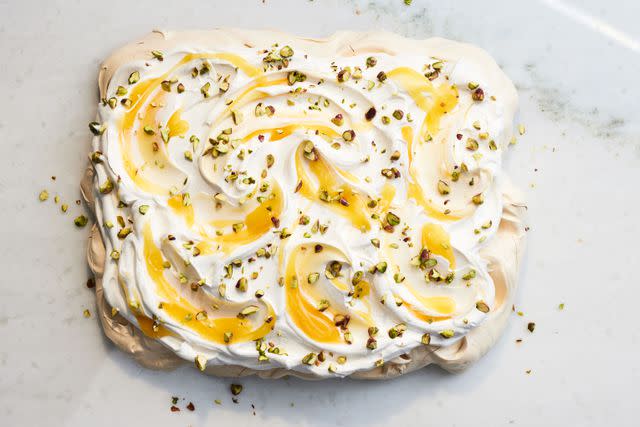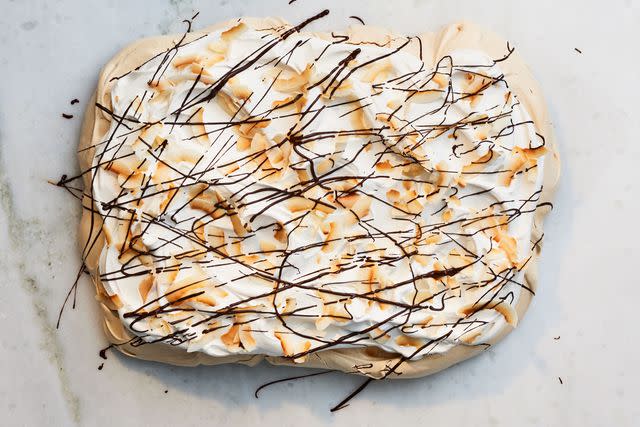The Easy Sheet Pan Dessert I Always Turn To When Entertaining
A pretty sweet way to end a meal.
Making dessert for a crowd is stressful. You already have a lot going on, from the centerpiece protein, to the myriad sides you have spread between the slow-cooker, stovetop, and remaining oven space.
Make-ahead desserts are always a good bet, but some require a full day’s work ahead of the main event, and then you’re burnt out before you even get to the savory side of things.
This is why I turn to a sheet pan pavlova. It requires very little hands-on work to make ahead of time, and not only can you prepare the meringue a day ahead, it's even better when you do. Then all you have to do is top it when you are ready to serve.
Don't just take it from me; try our Strawberry-and-Basil Pavlova yourself.
Strawberry-and-Basil Pavlova Recipe
What Is A Pavlova And Why Is It Great For Entertaining?
A pavlova sounds fancy, and I’ll admit it looks pretty impressive too, but it’s just baked meringue. The only equipment you’ll need to make it is an electric hand or stand mixer and a sheet pan—although, you could whip it up by hand, if you’re looking for a good upper body workout.
The meringue in this recipe is made with both white and brown sugar, for added color and flavor, but if you only have white sugar that will work, too.
Spread evenly over a sheet pan, the meringue bakes at a low temperature before resting in an turned off oven to dry out, for the perfect crisp exterior and marshmallowy center. The meringue is then topped with whipped cream and fresh berries, and finished with baby basil leaves (but you can leave those off, if you like).

Victor Protasio; Food Stylist: Melissa Gray; Prop Stylist: Christine Keely
The baked meringue base is a blank canvas for any toppings, but my recipe offers two variations to start with: lemon-pistachio and a riff on a coconut macaroon using coconut chips and a chocolate drizzle.
The large format dessert is easy to slice into any-size squares and much like a pizza, toppings can be split—for example one half with fruit, and the other with chocolate, to appease everyone.
Since it’s naturally gluten-free and can be made dairy-free, pavlovas are perfect for serving year-round to guests with dietary restrictions around wheat or dairy products, or in observance of Passover.

Victor Protasio; Food Stylist: Melissa Gray; Prop Stylist: Christine Keely
5 Tips For Pavlova Success
Pavlovas don’t require special baking equipment, tons of ingredients, or much hands-on cooking time, but as with any dessert, there are dos and don’ts.
Avoid humidity
Pavlovas are just not made for July in the South (to be fair, I wasn’t made for it either). The humidity can make your meringue weep.
If you’re hosting a summer soirée, it's best to go with another dessert. Also, try not to run the dishwasher (especially if you have a small kitchen like mine) while making a pavlova, as the steam from the machine will make your kitchen more humid.
Mind the yolk
Separating egg whites can be a pain, but it’s important to do it carefully for pavlovas as even the tiniest bit of yolk can interfere with the egg whites’ ability to whip up into stiff peaks. Any residual fat or grease on the beaters or the bowl can also prevent the egg whites from whipping up properly.
Whip it real good
When it comes to pavlovas, you need to add the sugar slowly; otherwise some of it may not incorporate properly, and this too can cause weeping.
A classic test to see if the sugar is properly incorporated is to pinch a bit of the meringue between your fingers and rub them together. If you can still feel granules, keep whipping until the sugar is dissolved and no longer perceptible. Ultra-fine sugars, or even pulsing your sugar in the food processor beforehand, can make the crystals smaller and easier to incorporate.
This pavlova uses brown sugar, and it's important to make sure it's lump-free. (If it’s been sitting in the back of the pantry awhile, I can almost guarantee it's not.) Sift your brown sugar before adding it to the egg whites to avoid chunks of it in the finished pavlova.
Go slow and steady
You can’t rush a pavlova. It must be baked low and slow, then allowed ample time to slowly cool and dry out, or it will collapse. Use the downtime while baking and cooling to prepare for other dishes you’ll be serving at your event. Or binge watch a tv show—you deserve some down time before entertaining.
Serve immediately
While you can bake the meringue ahead of time, you should wait to top it until you're ready to serve. The whipped cream and juicy fruit will start to breakdown the meringue and by the time it is served, it might be a soggy mess.
For fuss-free serving, you can have your whipped cream already prepared, and your fruit ready to go, then just spoon them over the top after dinner is finished.
For more Southern Living news, make sure to sign up for our newsletter!
Read the original article on Southern Living.

